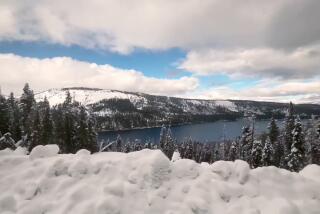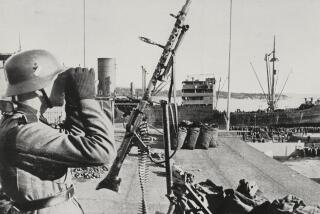A Glory Train Ride, Oslo to Bergen
- Share via
BERGEN, Norway — Among the great train rides, the one between Oslo and Bergen, Norway’s two largest cities, has to rank near the top of the world’s ever-diminishing rail journeys.
It rivals the Panama Canal not only as an engineering feat; the comparison goes further because you leave Oslo at sea level, cross the roof of Norway and arrive at Bergen, also at sea level, seven hours later. You will pass through 200 tunnels, cross 300 bridges and traverse 15 miles of snowsheds.
It was cold as we boarded in November. Hundreds of commuters were arriving and because there are no porters in Norway, you are well advised to carry your luggage to your assigned car.
Norwegian trains, like those of Switzerland, are punctual, and so precisely at 7:30 a.m. our train headed out of the glass-roofed depot. Once past the industrial fringes of Oslo, one should be poised for hours of incredible scenery.
I had a leisurely breakfast in the dining car: fresh rolls, Danish ham, cheese, a soft-boiled egg, strong coffee (a good buy at 45 kronen), and studied the countryside, which was reminiscent of southern Germany. There are small, well-tended farms, two-story farmhouses painted either boxcar red or bright yellow, with cords of pine stacked neatly under the eaves.
Gol, Al and Mol
The ascent is gradual, almost unnoticeable, as you cross and recross raging streams, pass lakes with small rowboats hauled onto shore. We stopped at Gol (elevation 205 meters), thence at Al 15 minutes later (elevation 460 meters), thence at Mol at 10:45 (elevation 608 meters). There were small, well-kept stations reminiscent of our early West.
I was fortunate that our car was relatively empty as I darted from left to right to watch one more lake, one more spectacular waterfall and, after Geilo, the imposing snow-covered ranges above the valleys.
One notices a subtle change in coloration. The green fields assume a straw color, lakes are no longer deep blue but assume the shade of pewter; pine trees give way to birch, then as the altitude increases, one sees willows.
Some 187 miles west of Oslo (five hours into your trip), all vegetation stops. The landscape is one of eternally frozen lakes and ice-blue glaciers, with an almost blinding brilliance of the sun reflected by all these white masses. The landscape is not unlike pictures of the moon. Our train stopped at Myrdal, one of the highest points on the line at an altitude of 4,262 feet.
This figure may not seem impressive to Americans used to the Sierra or Rockies, but here you are already in a very far northern latitude. No doubt the next 60 miles of the trip are the most awesome. It is like watching an old stereopticon or slides from a projector.
Flanking Snow Screens
At times you are only outside a snowshed for a moment and you strain to capture the view of another glacier, another imposing mountain range before you are once again enveloped in darkness. Flanking the train are wooden snow screens 20 feet high. Caterpillar plows are poised and ready to keep this trackage constantly clear.
(It was here, surrounded by this frozen country of snow, ice and imposing glaciers, that a young stewardess came down our aisle--selling ice cream.)
Slowly, the descent begins, and once more the all-white countryside is touched by nature’s palette. Pines reappear, so do spruce; once more the fields become increasingly green and the familiar farmhouses, smoke pluming from their chimneys, appear.
Stark, granite mountainsides are laced with long waterfalls that glisten in the sunlight like long strands of blonde hair cascading down a girl’s neck. The train is still crossing and recrossing the seemingly furious white-water streams.
Then slowly the landscape becomes more tranquil. One sees deep-draft vessels in an inlet and several entrances to fiords, which have made Bergen such a famous destination for travelers in the summer.
At 2:30 exactly our train arrived in Bergen. The temperature is 4 degrees centigrade and I registered at the Hotel Terminus across the street from the station.
I wanted to order a drink and propose a toast to the fine men who completed this line in 1909, but learned to my dismay that this establishment was a temperance hotel--no alcohol served.
So I raised a glass of water which, considering the experience, is probably more symbolic anyway.
More to Read
Sign up for The Wild
We’ll help you find the best places to hike, bike and run, as well as the perfect silent spots for meditation and yoga.
You may occasionally receive promotional content from the Los Angeles Times.






